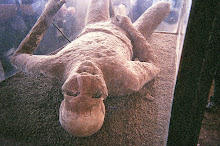

Have you ever thought about the world famous Roman Colosseum's origins or history? Well, the Colosseum's construction started between 70 and 72 AD under the Roman emperor Vespasian. He wanted to give back land that was stolen from Roman citizens by Nero. The roman emperor's son, Titus, completed the construction in 80 AD. The original name was the "Flavian Amphitheater." The amphitheater was renamed as the "Colosseum" for the colossus statue of Nero that was brought to the early structure.
The Colosseum could originally seat about 50,000 people. The main purpose for the theater was to hold gladiatorial games. Public announcements and speeches were also delivered from its' vast stage. It would also be flooded for mock sea battles and animal fights. To my surprise, I read that the Colosseum's arena was not sand or dirt, but it was actually made of wood. Below was a basement like area where animals and gladiators waited to perform.
The Colosseum was used for four centuries as the main fighting arena in Rome. After the Colosseum had officially opened, 100 days of games and fights were held.


